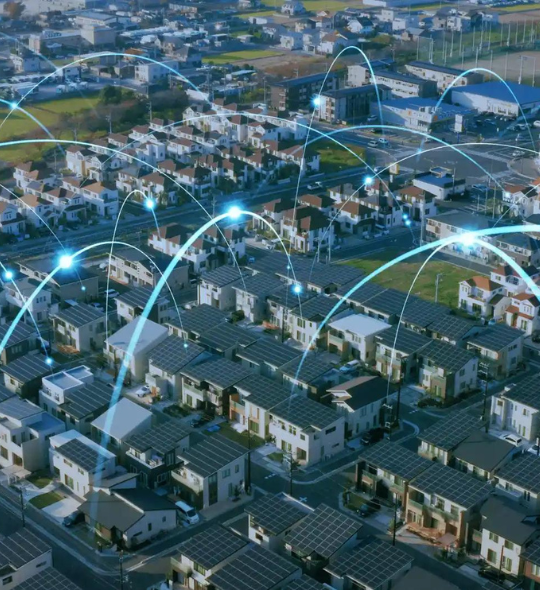
We all know the cliché about asking your neighbour to borrow a cup of sugar, but have you ever thought of asking to borrow your neighbour’s electricity?
TL;DR
-
Peer-to-Peer (P2P) energy trading allows owners of solar cells, batteries, and electric vehicles to buy and sell renewable energy to each other, earning more while still being cheaper than utility rates
-
P2P energy marketplaces rely on blockchain to manage and track energy transactions, while helping automate network balancing with tools like smart contracts
-
P2P networks need a level playing field vis-à-vis legacy utilities and retailers, and while P2P trading is taking off in many countries, legislation not technology is the main hurdle
As distributed renewable energy resources (DERs) like solar panels become more common, more people are turning to their neighbours for energy.
Peer-to-Peer (P2P) energy trading is the next step in the evolution of the sharing economy. Residents can benefit from local generation and storage hardware, boosting local resiliency and helping promote grid digitalization. As a result, we are seeing the rise of a new hybrid energy user – the prosumer – part producer and part consumer.
P2P networks can capture more of the value of DERs, increasing revenue for asset owners while also lowering consumer costs. For example, PowerLedger, a P2P trading platform in Australia reported in 2017 that residential consumers saved an average of $424 per year on their electricity bills, while owners of rooftop solar saw double the savings they usually got from their PV systems.
The price of buying electricity from the grid is generally much higher than the rates you get selling excess energy back to the grid.
These low prices don’t take into consideration the value from reduced emissions, congestion, and transmission losses. According to the International Renewable Energy Agency (IRENA), around 41% of the typical cost of electricity goes towards maintaining and managing utility poles and wires that transfer energy from generators to consumers.
So it stands to reason that if electricity doesn’t need to travel as far, this should be reflected in lower prices for prosumers.
How does it work?
P2P energy marketplaces exploit the proliferation of smart sensors and use blockchain technology to make it possible for individual energy end-users to sell and buy electricity from each other. Using blockchain allows P2P marketplaces to securely and transparently track energy contracts and transfers.
This is important because once electricity is generated and circulating in the grid, you can’t distinguish electrons based on their generation source.
So in order to ensure that you really are buying electricity from a specific source (e.g. your neighbour’s rooftop solar array), you need a digital ledger that is both tamper proof and responsive enough to be effective.
The use of smart contracts which automatically complete at specific times or under certain market situations are another important element in designing a blockchain network for P2P energy trading.
Currently, potential P2P marketplaces can operate in two ways; either they take place in an isolated microgrid, or in a microgrid that is connected to the wider grid. In the first case, the P2P platform also has to assume the role of system operator in order to ensure that the supply/demand equation is balanced at all times in order to maintain grid stability.
This means that prosumers can’t be expected to buy and sell energy quickly enough to balance the grid, so this is where things like smart contracts and automation come into play. Blockchain may even be able to proactively alter the costs of electricity based on generation source or congestion, by exploiting data from local generation trading.
When a P2P marketplace is operating among subscribers connected to the main distribution network, several things need to be accounted for to prevent hiccups. Since the P2P network needs to interact with system operators and the electricity market, it has to figure out how power flow between participants will affect the local distribution network.
In the same vein, local distribution networks will need to be operated, maintained, and remunerated accordingly. The P2P network will also need to buy and sell excess demand from upstream generation when local generation overproduces or falls short.
Legislation, not technology is stymieing P2P trading
For both scenarios outlined above, it is ultimately the absence of conducive regulatory frameworks, rather than technology that presents the biggest hurdle.
That being said, these rules are not arbitrarily trying to hinder innovation, but are in place to ensure reliability and stability in the grid. Since P2P networks are hard for system operators to manage and can threaten traditional revenue streams for utilities, there is often resistance from legacy organizations.
In 2017-2018, in Victoria, Australia trialled a prototype online marketplace (involving 68 residential customers all with smart AC systems and 6 with solar PV systems and integrated batteries) for distributed energy generation.
Referencing the findings from that trial, ARENA explains that “[…] P2P trading does not create additional economic value, where a reduction in retail and network charges is not achieved through at least a commensurate reduction in costs achieved through [blockchain] or a P2P market.
In this case, value is only shifted away from the retailer and/or network […].”
In order to reap the full benefits of P2P energy trading, there needs to be a level playing field for platform-based businesses vis-à-vis traditional utilities and retailers.
In order to reap the full benefits of P2P energy trading, there needs to be a level playing field for platform-based businesses vis-à-vis traditional utilities and retailers.
For example, in Australia, only retailers see a decline in revenue when a low-cost P2P market administrator captures significant market share. Cutting out the middle man allows the P2P system to deliver savings to customers, but it is not actually driving any real net savings in the grid.
As the Australian Renewable Energy Agency (ARENA) notes, “[…] the viability of new products and markets, like P2P, are highly dependent on the underpinning network pricing framework.” The results from P2P pilot projects in Australia highlight the importance of reforming remuneration and pricing frameworks.
EU legislation passed in December 2018 explicitly addresses this need for a level playing field.
The EU Commission directive entitles renewable energy consumers to engage in P2P trading without disproportionate or non-discriminatory (network) charges, fees, levies, taxes or procedures.
Specifically, the Commission stated that “the right to conduct peer-to-peer trading shall be without prejudice to the rights and obligations of the parties involved as final customers, producers, supplier, or aggregators.”
P2P projects around the world
The Commonwealth Scientific and Industrial Research Organisation (CSIRO) forecasts that 35% of all electricity in Australia will be generated and managed by consumers by 2050. Australia is a leader in rooftop solar adoption, and it has the highest proportion of prosumers in the world with 1.6 million photovoltaic systems totalling 5.7GW in 2017.
More recently, Australia’s Decentralized Energy Exchange (deX) – which was created in March 2019 – allows households and businesses with solar and battery storage assets to earn revenue from their distributed energy capacity.
Solar power, battery storage systems, and electric vehicles are all becoming more common, and outside of Australia P2P pilot projects have also been set up in: Bangladesh, Columbia, Germany, Japan, Malaysia, the Netherlands, UK, and USA.
In 2014, the Vandebron P2P platform was launched in the Netherlands by Vattenfall AB (the largest utility in the Nordic region).
The trading platform allows companies to sell energy services to consumers, with both parties paying the utility a monthly subscription fee ($12 in 2020). Consumers are also able to purchase excess solar energy from their neighbour’s roofs.
Decentralizing and democratizing electricity generation is part of a wider economic shift from mass production to customizable, personalized products driven by leveraging consumer data.
In Germany, the firm Sonnen created the sonnenCommunity platform in 2015, which allows prosumers to trade surplus solar among themselves. Excess energy cannot be fed into the grid during times of oversupply, so net exchange between prosumers must always be zero.
This can create nominal independence from traditional retailers, but not from the grid access hierarchy or default prices for excess PV solar. Energy prices are fixed at around $0.25 per kWh and the platform charges users a monthly fee of $25 (2019).
New York was home to the first commercial solar panel (installed in 1884) and is now home to one of the first community microgrids using a P2P energy trading platform. The Brooklyn Microgrid connects solar array owners to their neighbours, with users accessing the local energy marketplace via an app.
Prosumers and consumers can select their preferred energy service, and can decide to choose whether they want to sell excess solar or continue net metering with the utility ConEdison. App users can also set their daily budget for purchasing local energy.
Decentralizing and democratizing electricity generation is part of a wider economic shift from mass production to customizable, personalized products driven by leveraging consumer data.
Many of us already rely on the sharing economy for products that used to be seen as deeply private items (e.g. vehicles), and P2P electricity sharing facilitated by blockchain and microgrids is just the next step.




